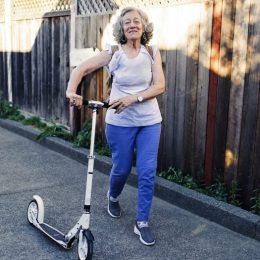The Best Way to Lose Weight After 60
Slim down, gain energy, and feel better from head to toe with these eight steps.

So you want to drop a few pounds. Why?
The answer may seem obvious, but until you identify it—to lower your blood pressure, put less stress on your joints, or boost your confidence—you’re doomed to failure.
Successful weight loss, particularly for older adults, comes down to three things: a goal, deadline, and strategy, says Michael Dansinger, M.D., a weight loss expert at Tufts Medical Center in Boston. Follow these eight steps to lose weight after 60.
Step #1: Get in the Right Mindset
Before you even set a weight loss goal, preparing yourself mentally is a must. "This is half the battle," Dr. Dansinger says. "Acknowledge that you will come up against challenges and your instinct will be to quit."
The secret to getting past these challenges is to anticipate them and decide in advance that you will keep you going.
Step #2: Write Down Your Motivation
Knowing and remembering why you want to lose weight will help you stay on track. Do you want to improve your self-esteem? Have more energy for everyday activities or to finally go on the vacation of a lifetime? Lower your risk of heart attack and stroke, or decrease symptoms of diabetes?
Whatever your reason, write it down, Dr. Dansinger says. Hang the paper where you'll regularly see it. On days you're feeling less motivated, it'll remind you why you're putting in the effort.
Step #3: Give Yourself a Deadline
Make a specific timeline with an end date and dates to check in. This is especially helpful if you’re working toward a health goal, like lowering your blood pressure, so you can track your numbers.
Try checking in once or twice per month, which will give you enough time for measurable change. It may also help to take a photo of yourself on these dates so you can see your progress.
If you have a big weight loss goal in mind—say, you want to lose 25 pounds or more—set a smaller goal and a shorter timeline to start. As you make progress, you’ll gain confidence, and you can set a new goal and timeline.
Step #4: Tell Your Team
You're more likely to stay on track if you tell someone about your goals and progress, Dr. Dansinger says. A family member, friend, doctor, fitness instructor, or dietitian can provide support.
You can also find support in a weight loss group or an exercise class. Most SilverSneakers members, for example, don’t join to make new friends—but 49 percent of members are motivated to continue exercising because they have a buddy in the program. In fact, it’s one of the reasons why SilverSneakers members love our classes.
Step #5: Schedule Your Workouts
It's not enough to promise yourself you'll exercise. You should schedule every session: the day, time, type, and length. Put them on your calendar, Dr. Dansinger says, so you're less likely to skip.
Want to make it easier? Schedule and track your workouts with the SilverSneakers GO app (free, iOS and Android).
Step #6: Choose a Realistic Eating Plan
Exercise with or without weight loss is always positive. You're improving blood flow, strengthening your bones, and lowering your risk of many diseases.
But exercise alone won’t flatten your belly. You also need to improve your diet. Luckily, you have a lot of flexibility. “Eating plans are like the colors of a rainbow,” Dr. Dansinger says. “There’s no one color for everyone, and there’s no one eating plan for everyone.”
Make sure you choose a plan that fits your lifestyle. If you love steak, a vegetarian diet may not be something you can stick to. Instead, focus on eating less meat and more vegetables.
Subscribe to our newsletter
It's quick and easy. You could be one of the 13 million people who are eligible.
Already a member? Click to discover our 15,000+ participating locations.
Follow Us
Similarly, if you regularly hit the drive-thru, cooking from scratch every day may not be realistic. But you can keep healthy foods in your freezer to make a few dinners each week. And when to-go is your best option, look for nutritionist-approved fast food meals.
Step #7: Allow Yourself to Cheat
Not only is it okay to cheat a little, it's actually important to give yourself wiggle room in your diet. Commit to your eating plan 90 percent of the time, but allow yourself to splurge 10 percent of the time, Dr. Dansinger says.
If you let yourself eat a cookie now and then, you’ll be less likely to break down and eat a sleeve of Thin Mints in one sitting.
Too tempting to keep treats at home? Plan coffee and dessert with a friend. You'll satisfy your sweet tooth, get out of the house, and squeeze in some quality time all at once.
Step #8: Keep Your Doctor in the Loop
Can’t seem to get the scale to budge after a month or two of exercise and healthier eating? It could be a sign you’re already at the right weight or there’s an underlying health issue going on. If you haven’t already checked in with your doctor, now’s a good time.
In some cases, your doctor may recommend working with other health experts. If you've been limited from exercise because of injury, a physical therapist can help you get moving again safely. Or if you have diabetes, your diet will be an important part of your treatment plan, and a dietitian can help you get started.
Take Your Favorite SilverSneakers Classes Online!
SilverSneakers members can access live fitness classes and wellness workshops through SilverSneakers LIVE. See the latest schedule and RSVP for classes here.
Not a member? If you have a Medicare Plan, it may include SilverSneakers—at no additional cost. Check your eligibility instantly here.




